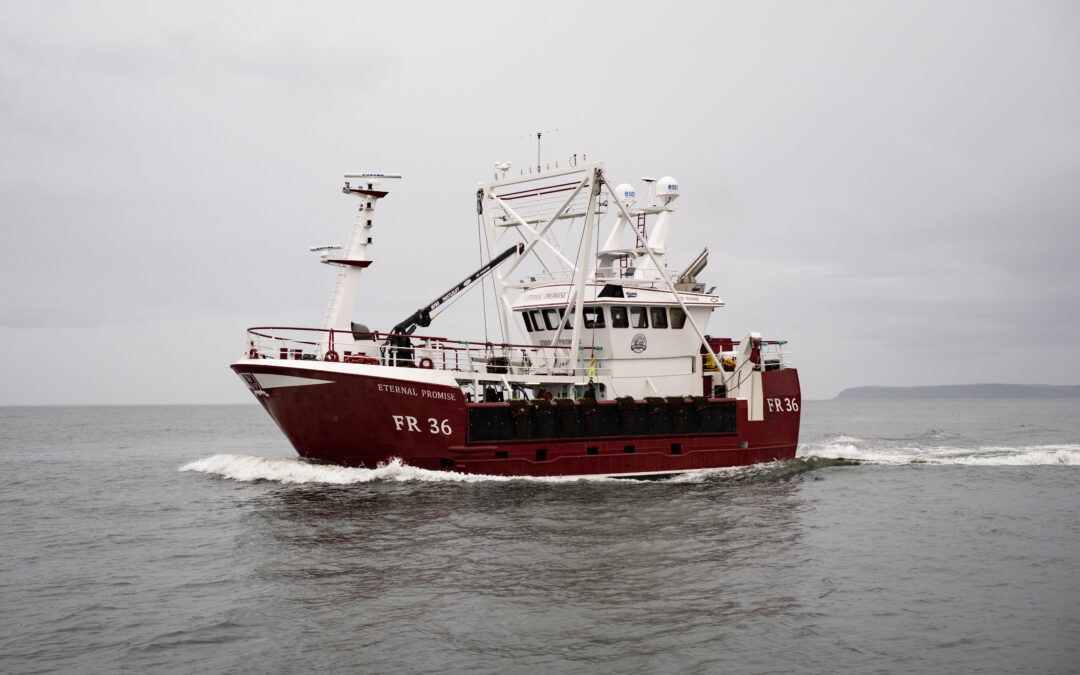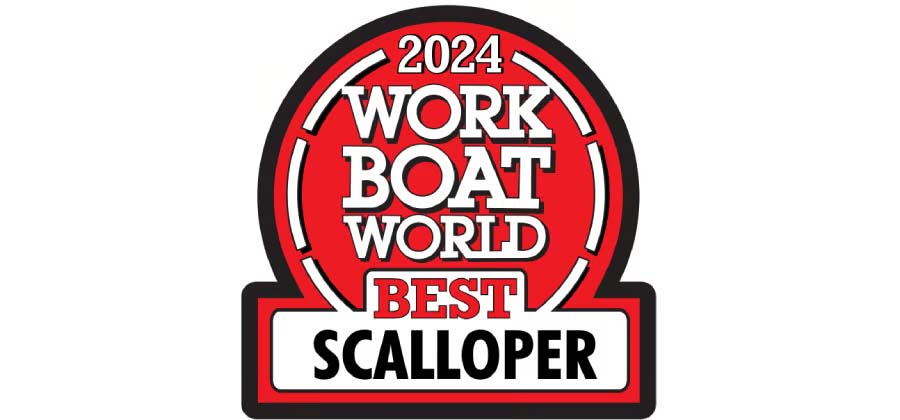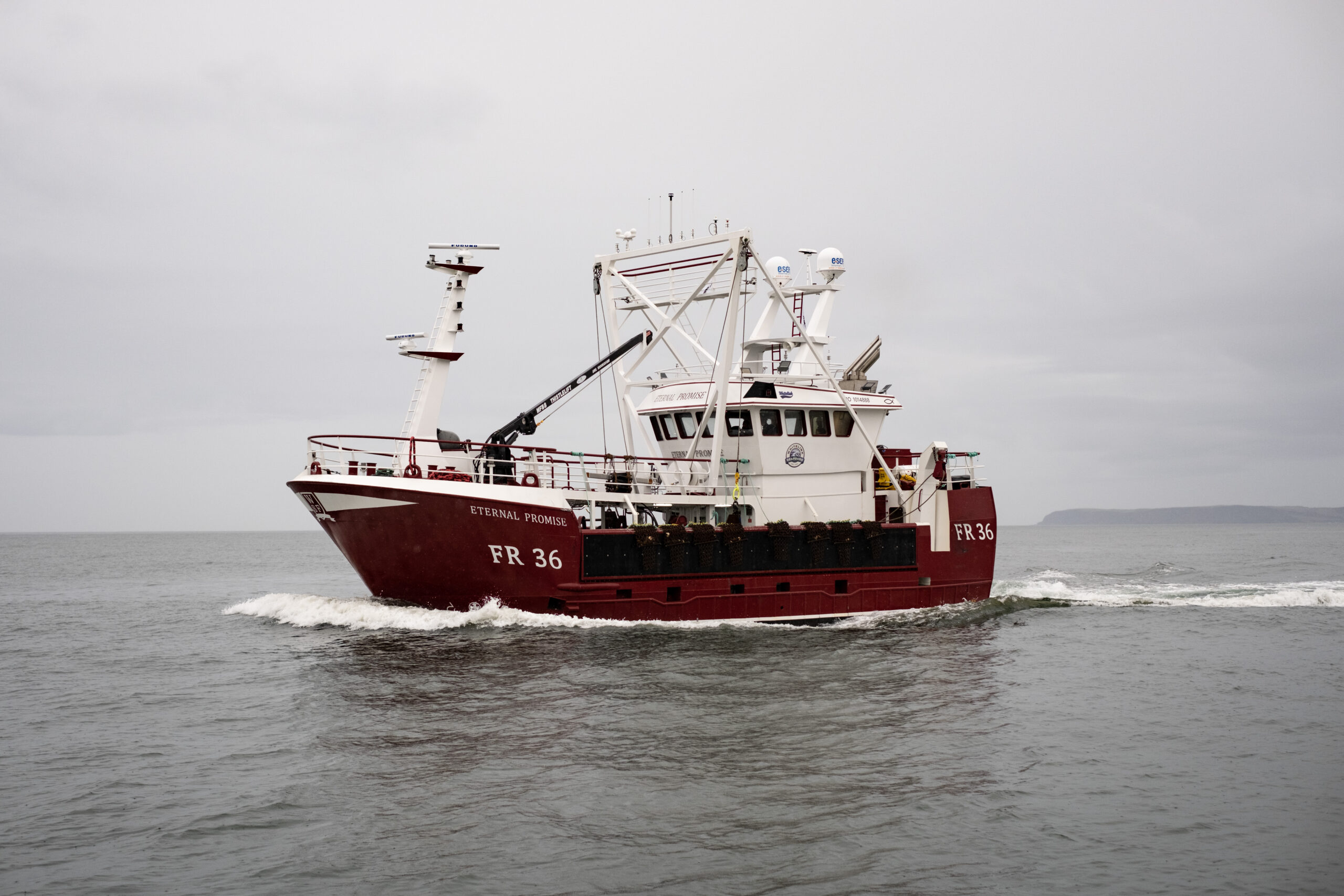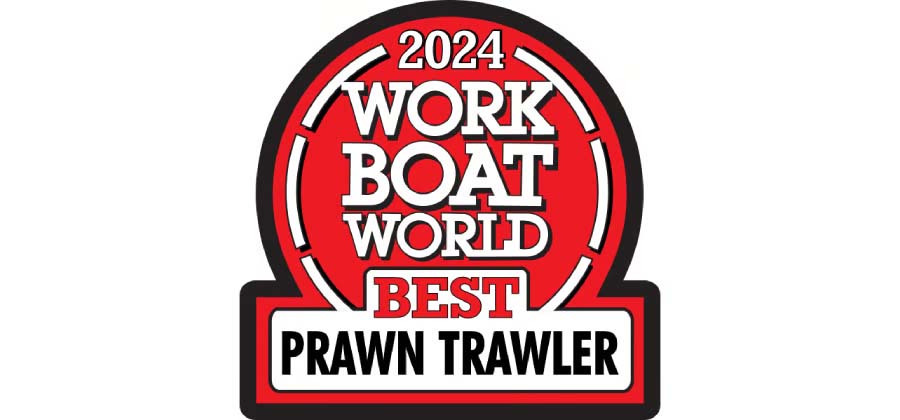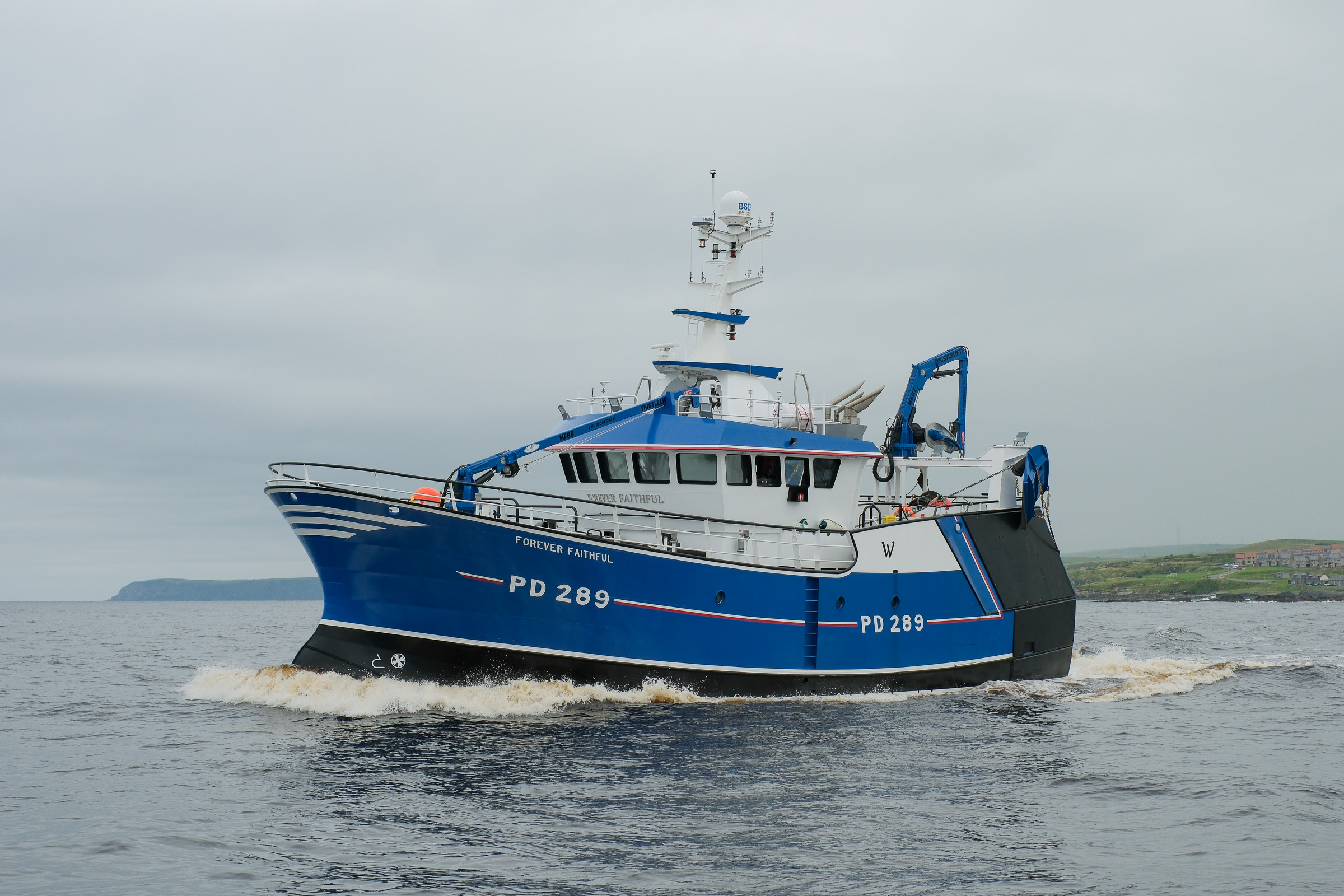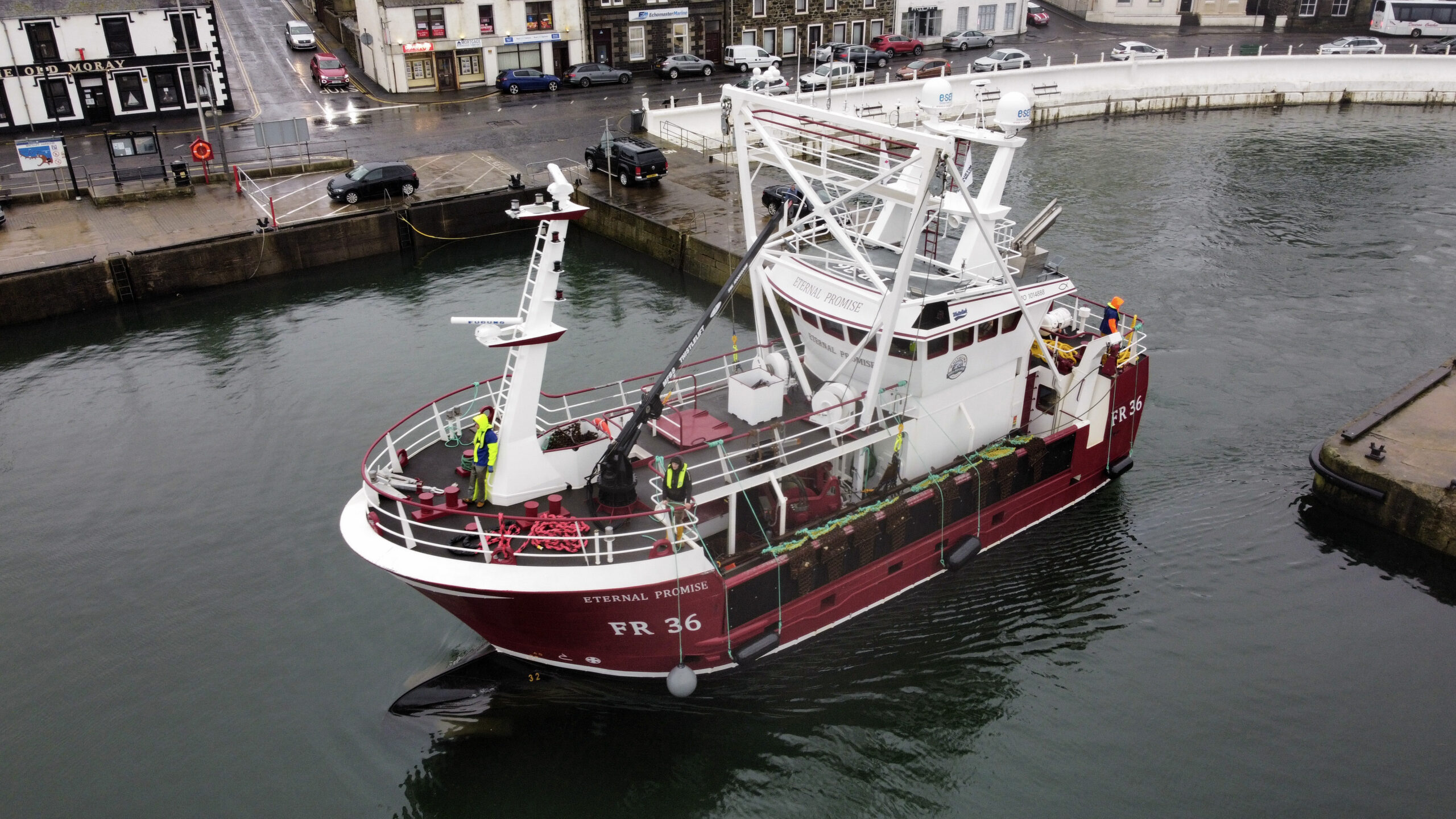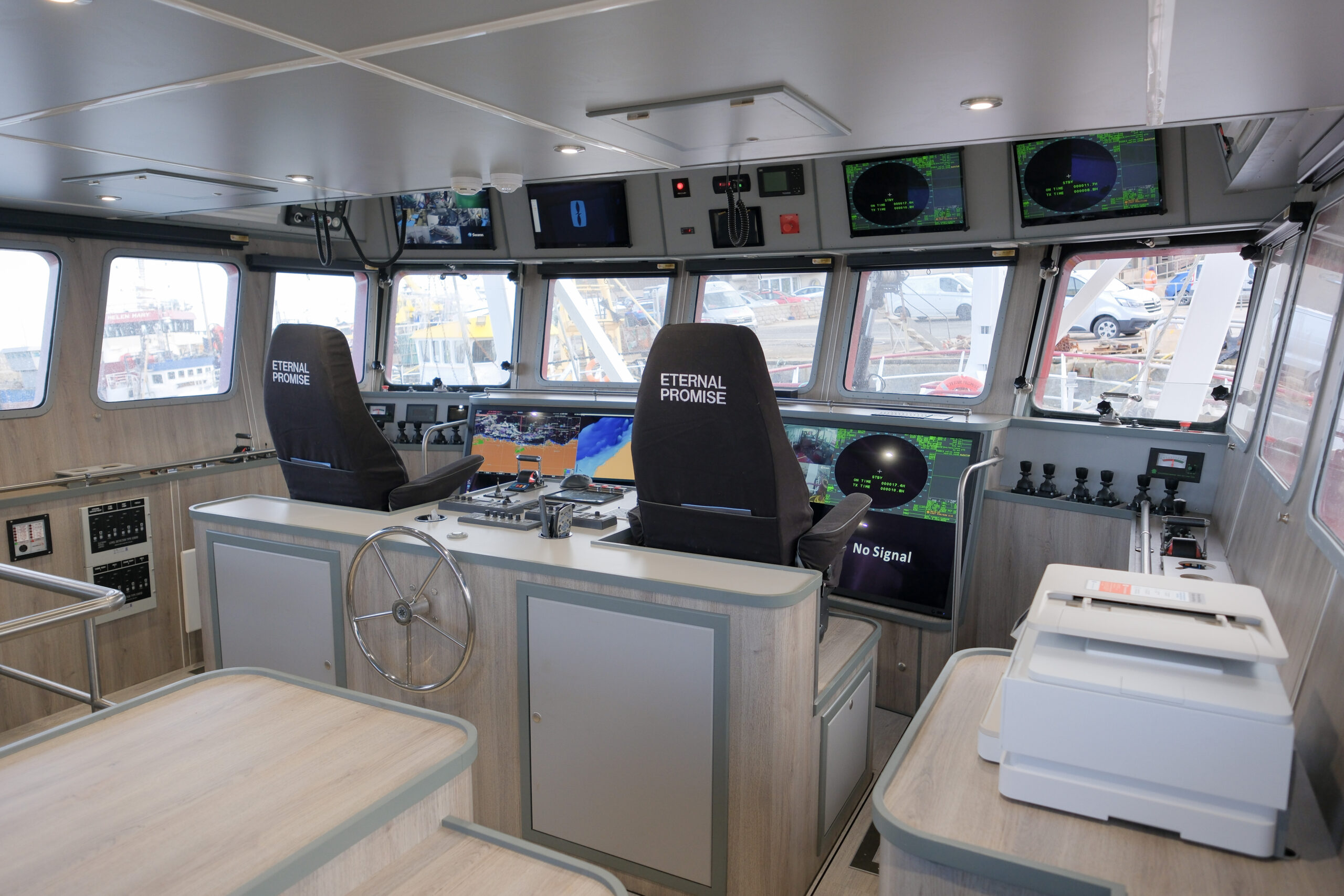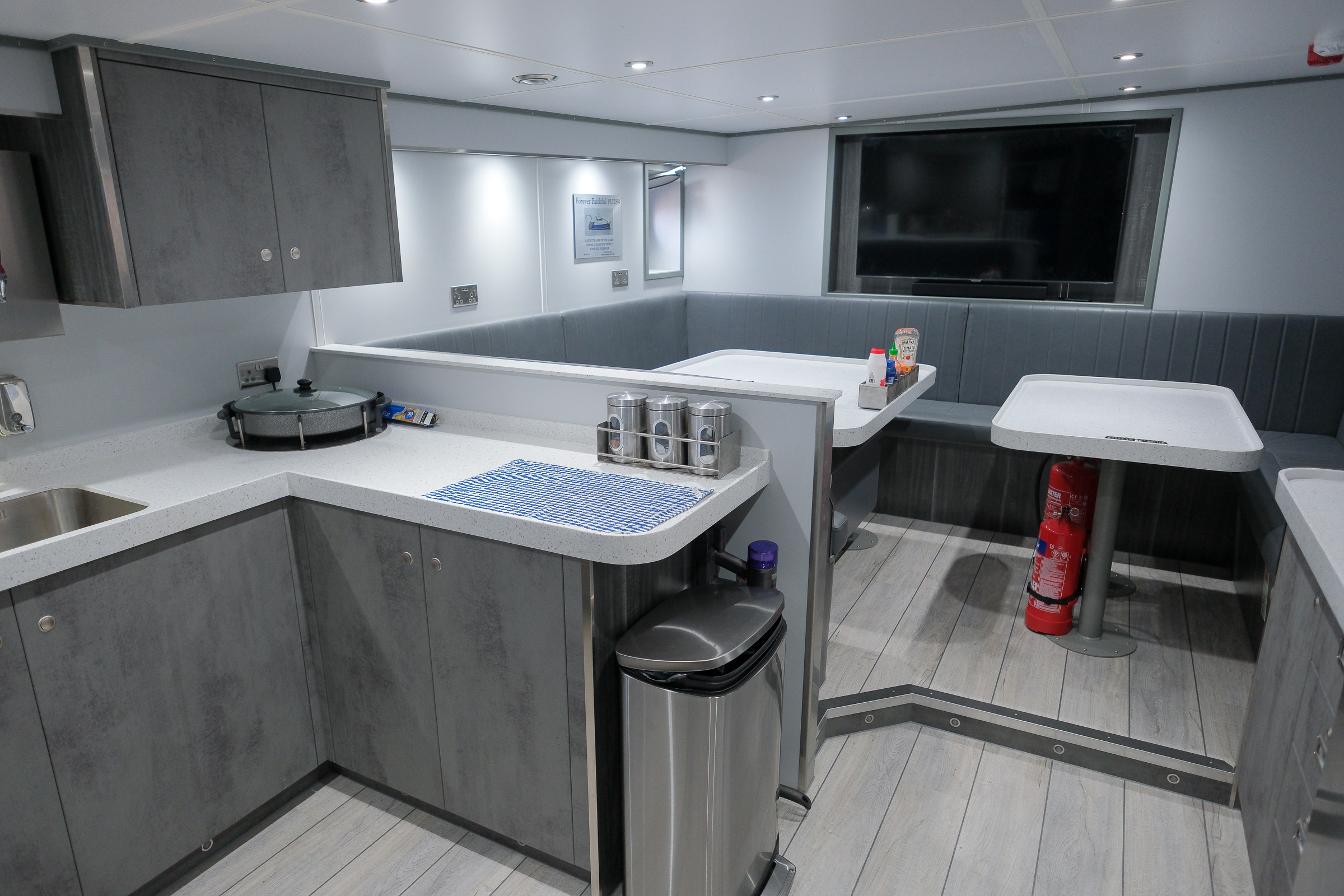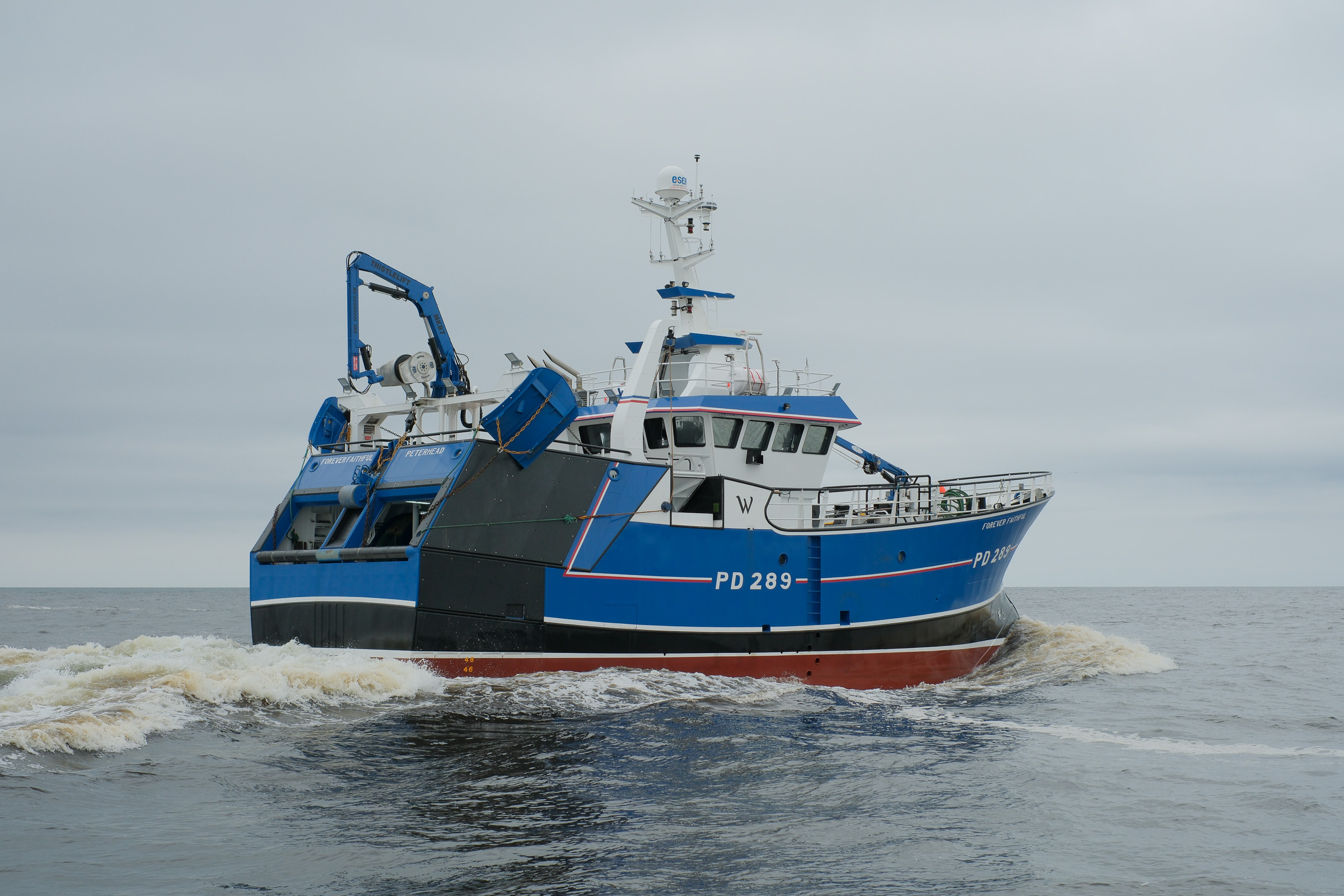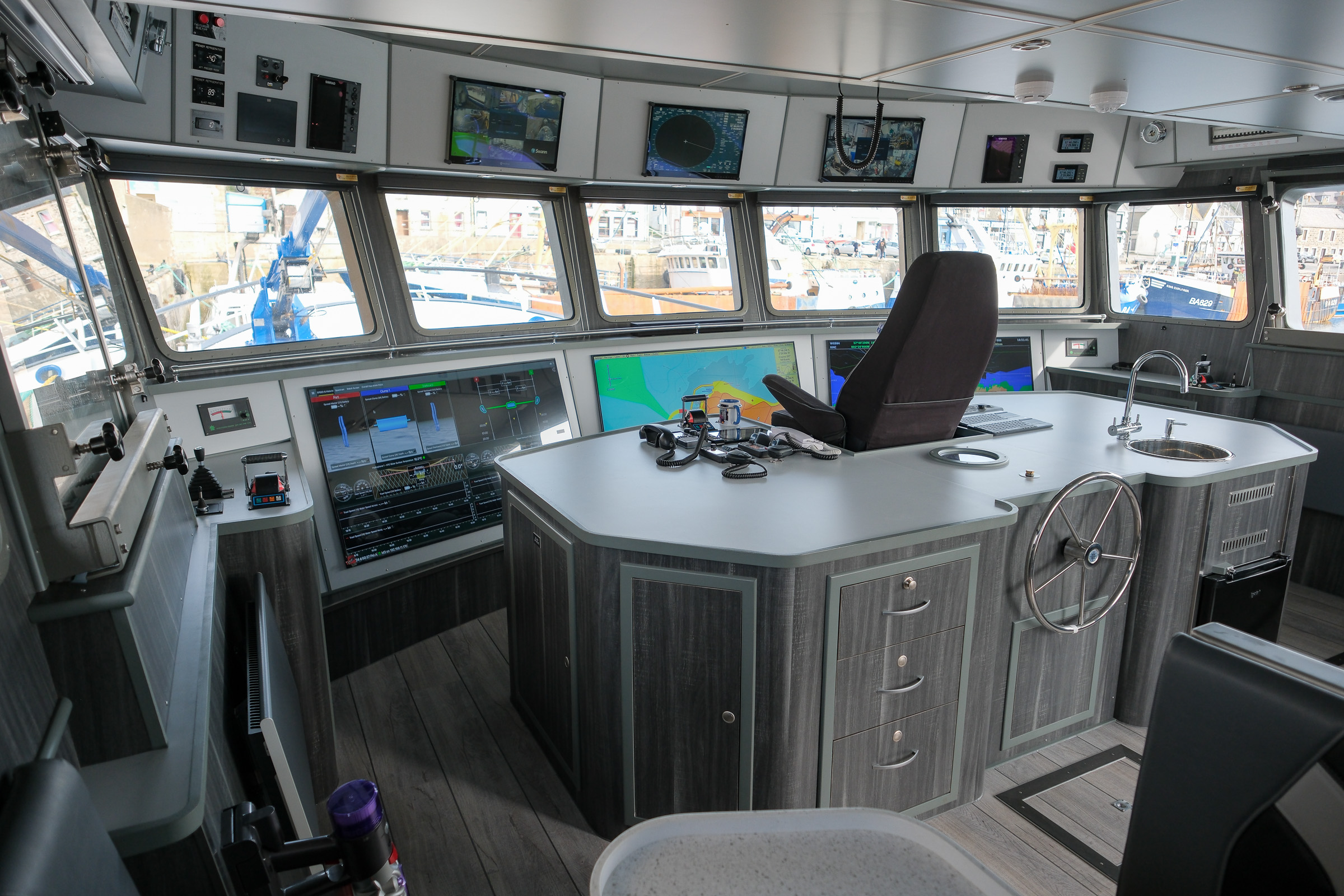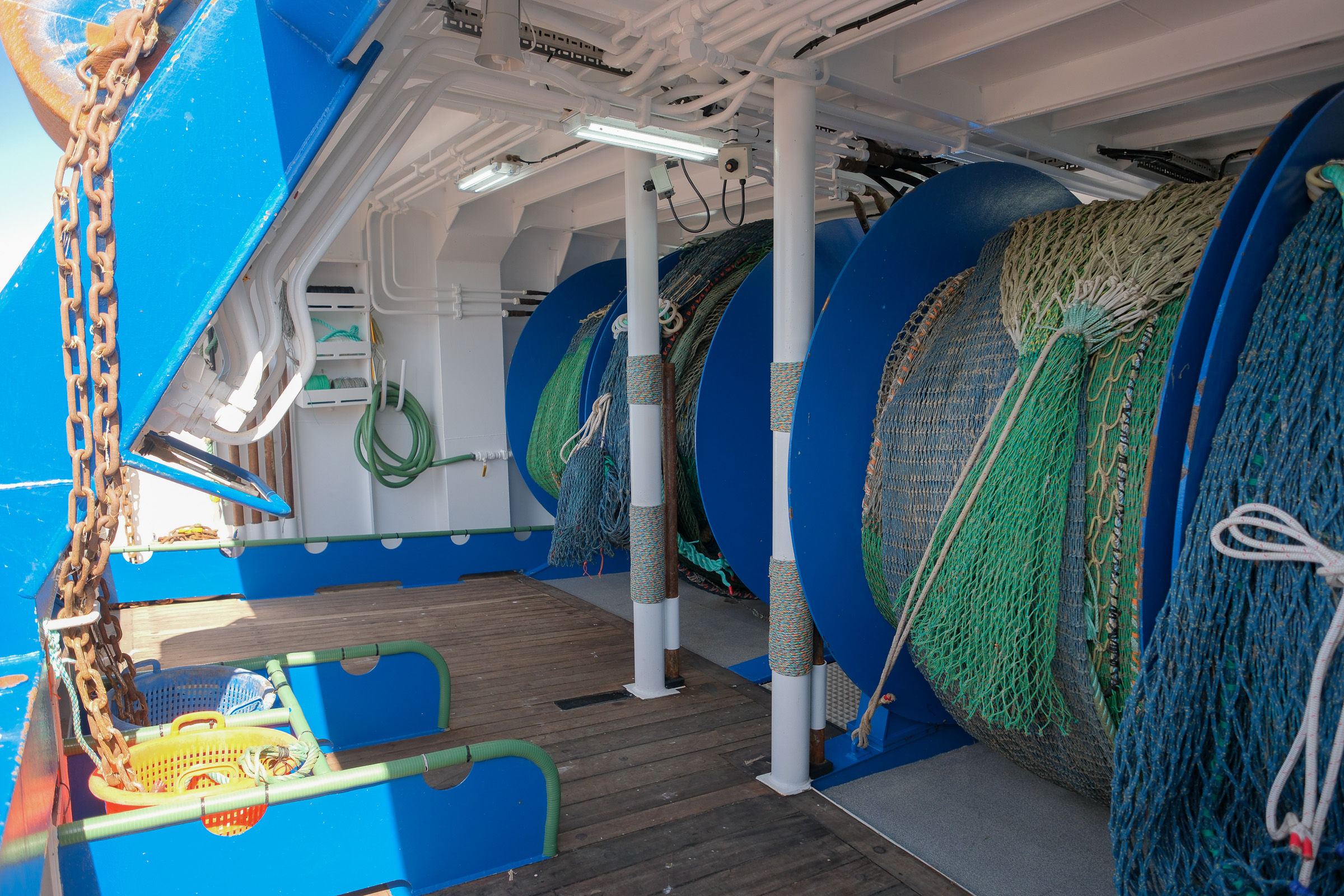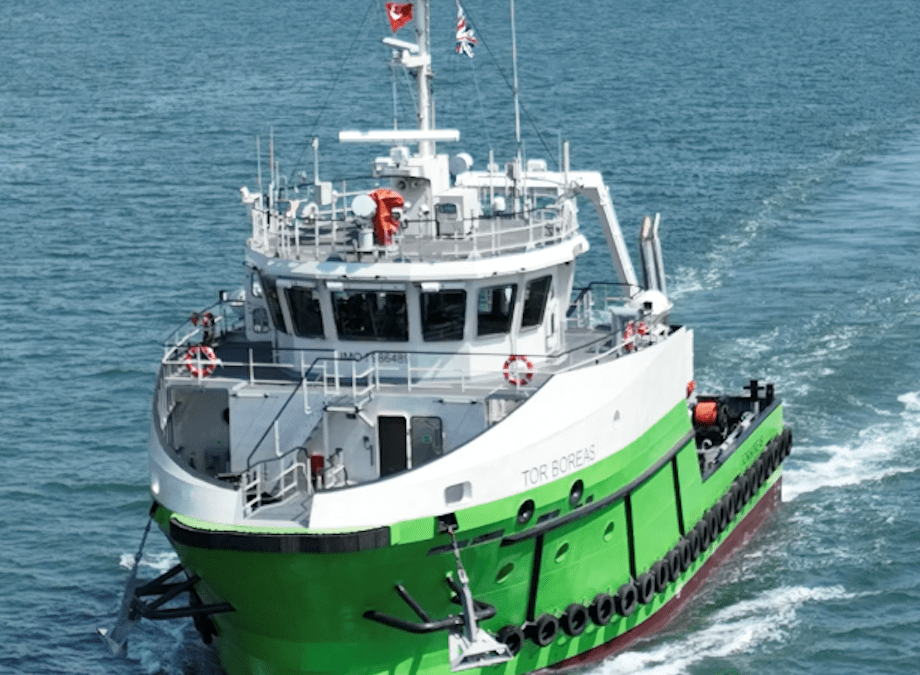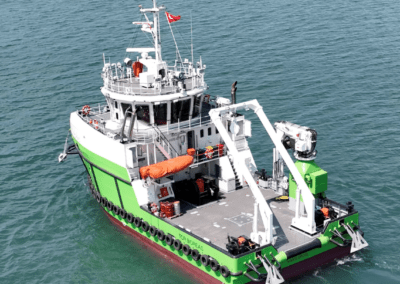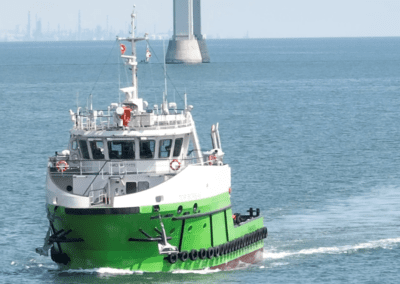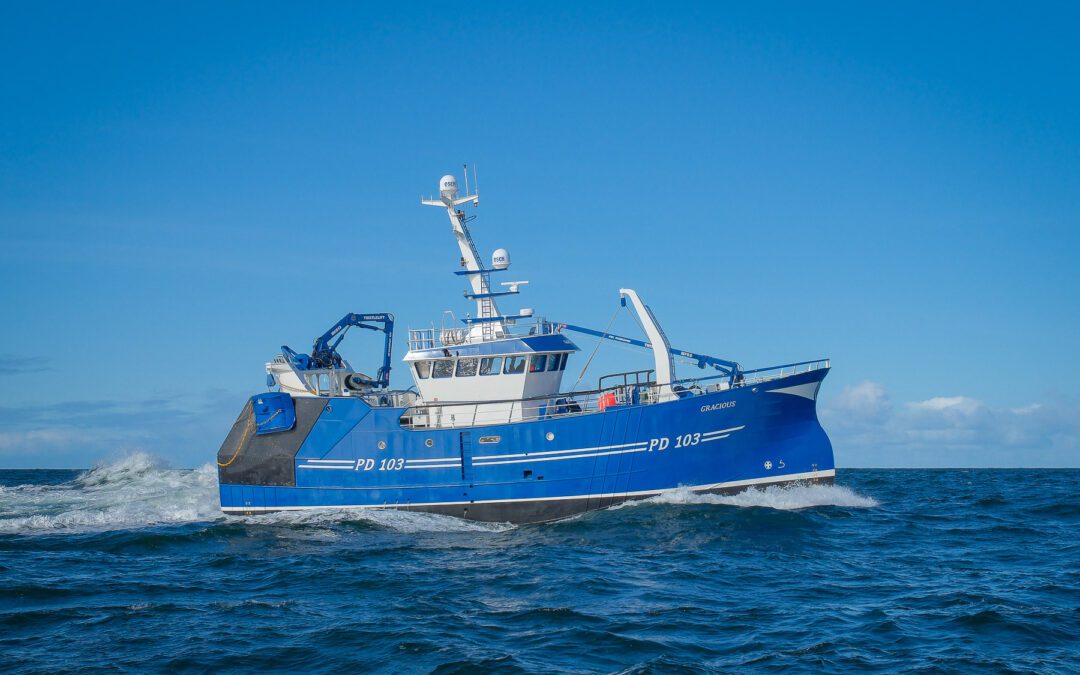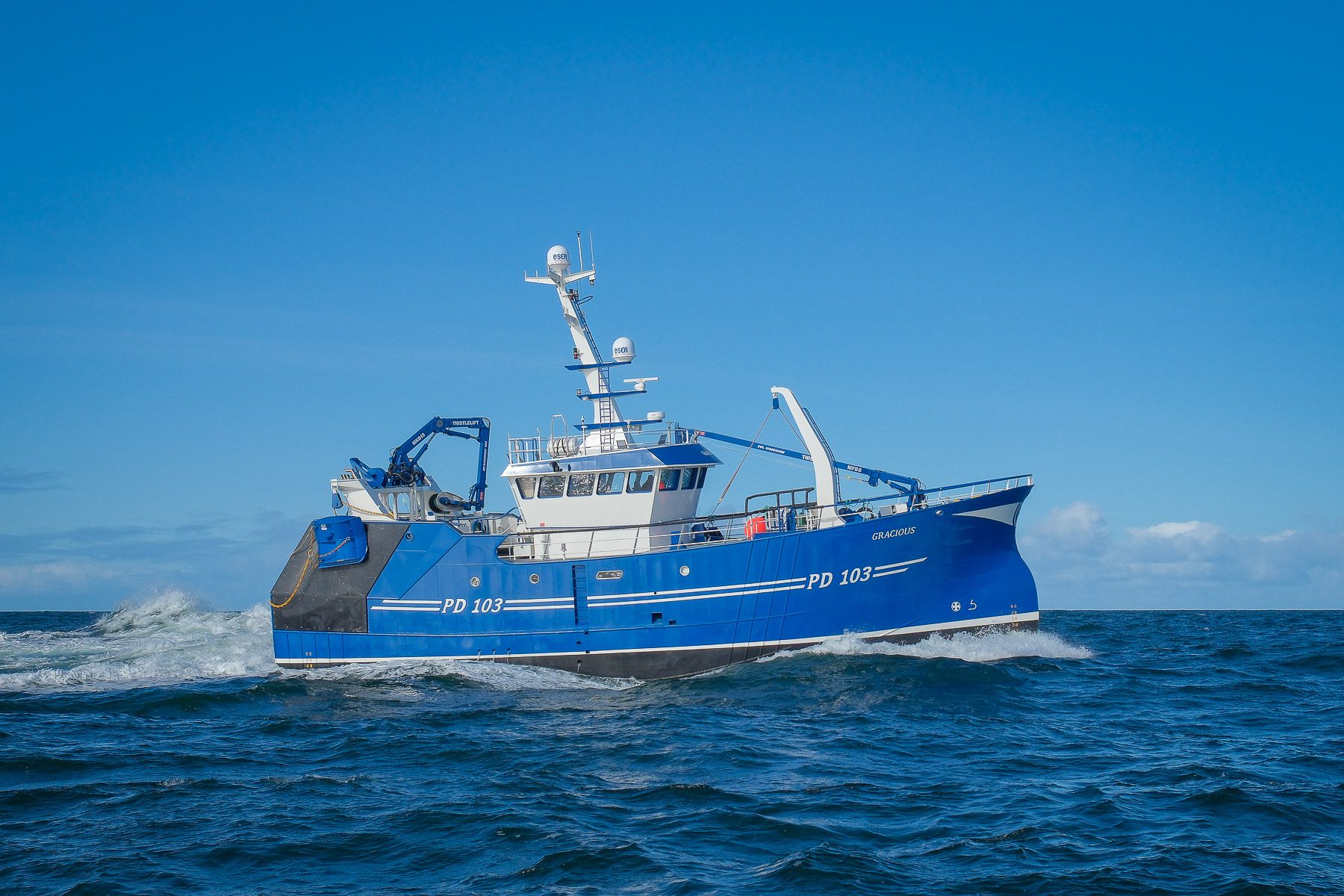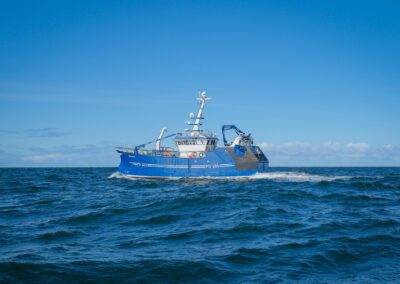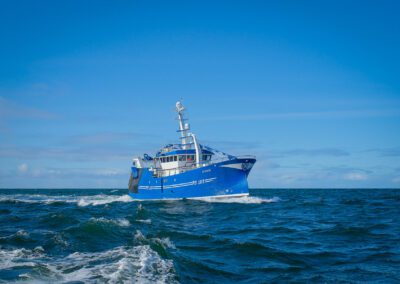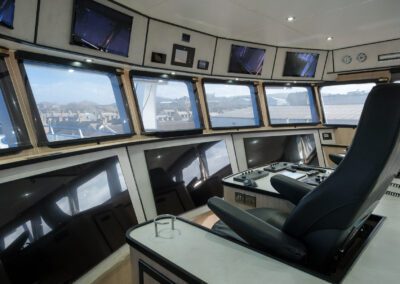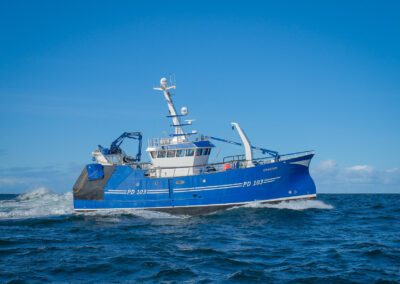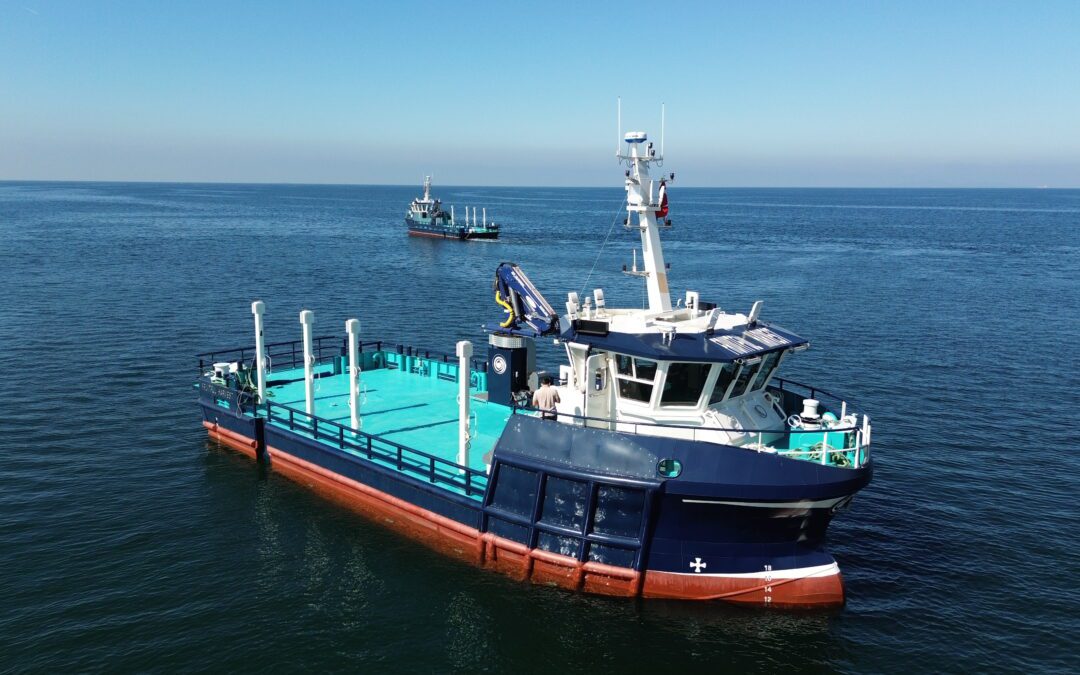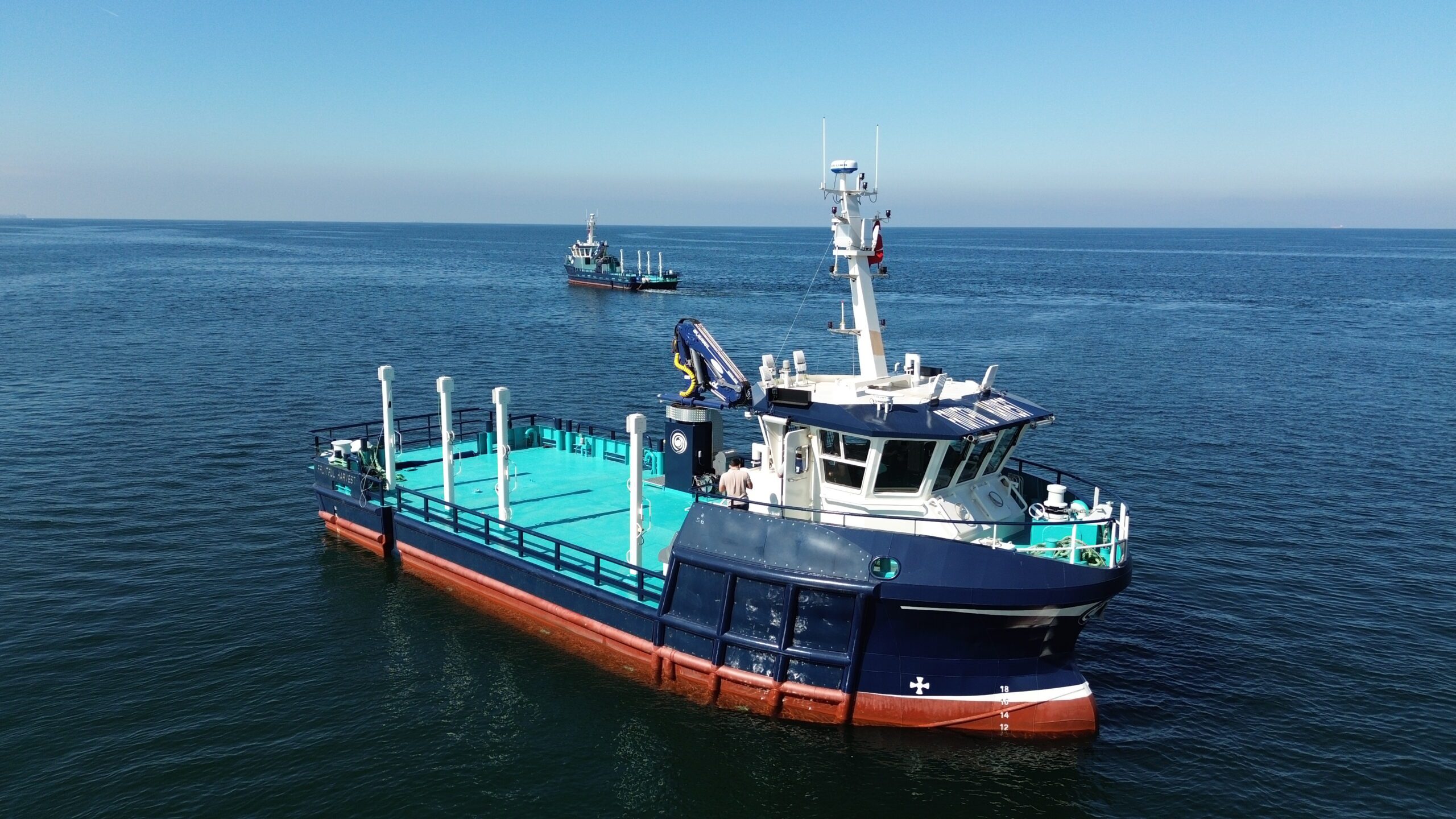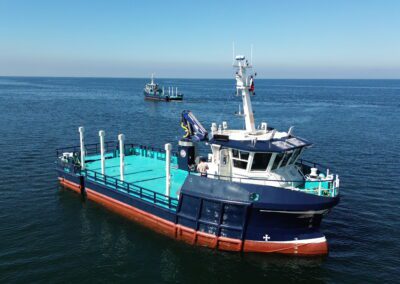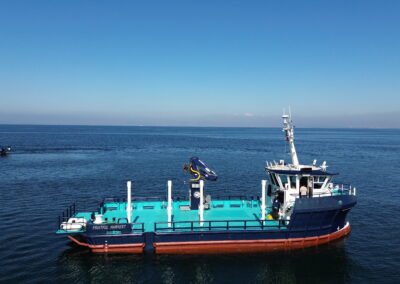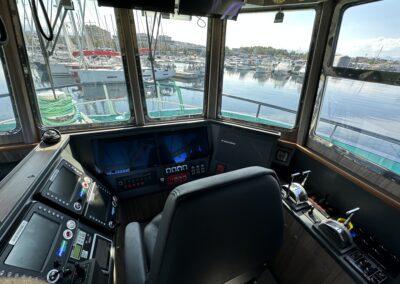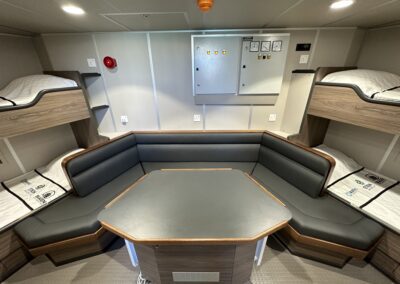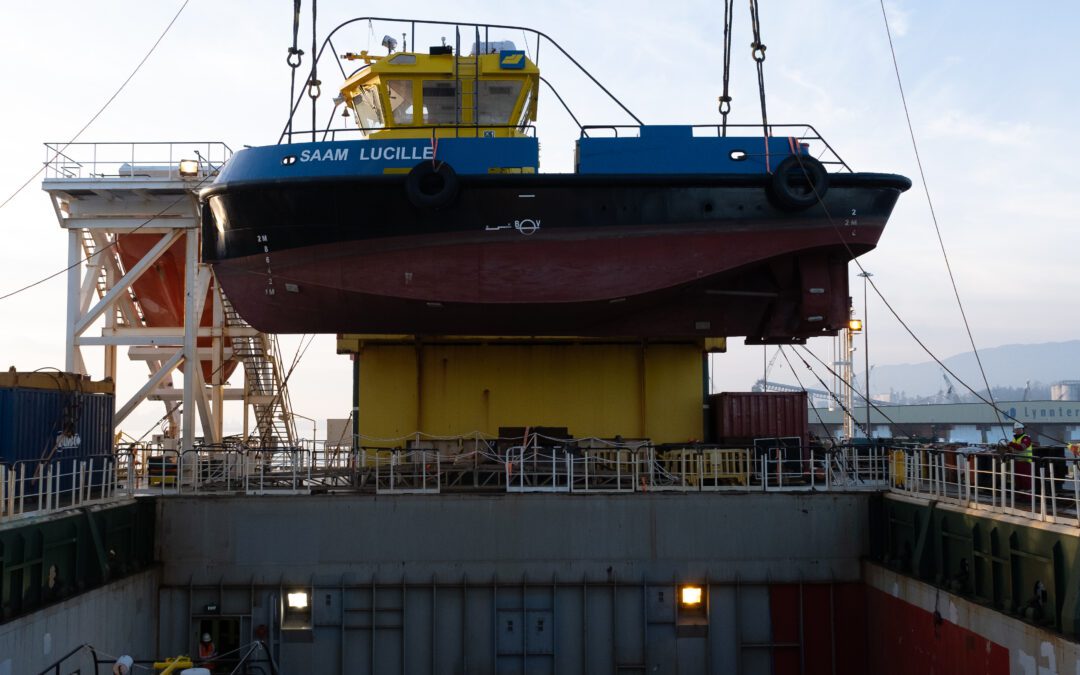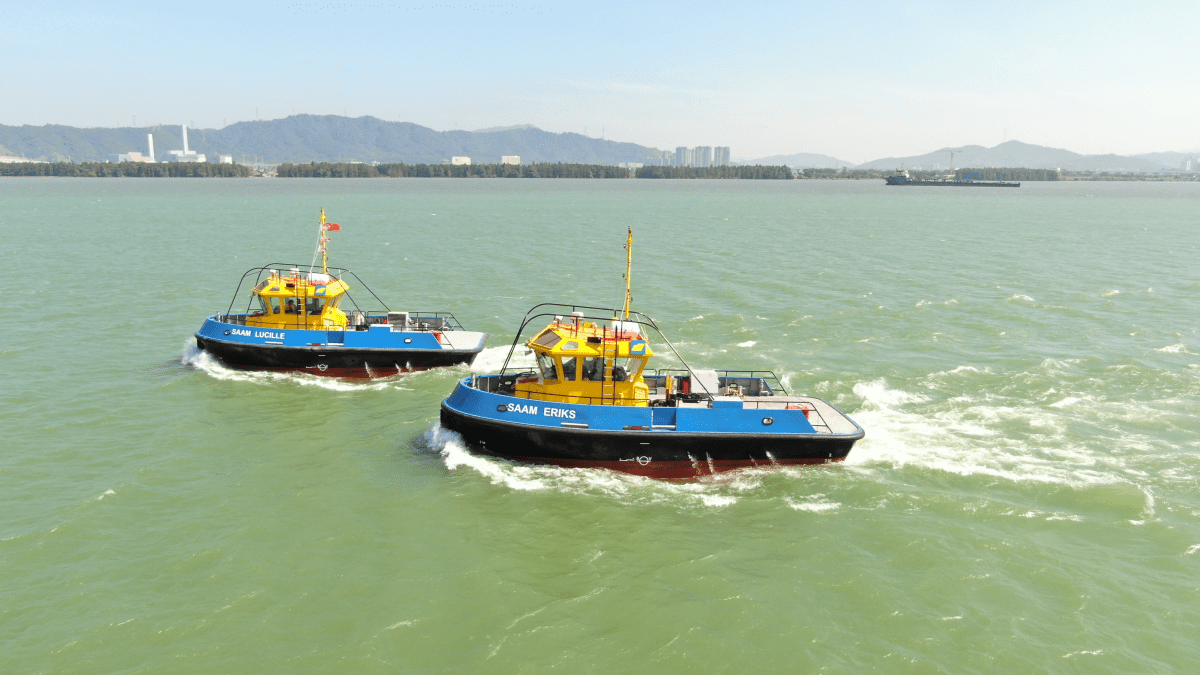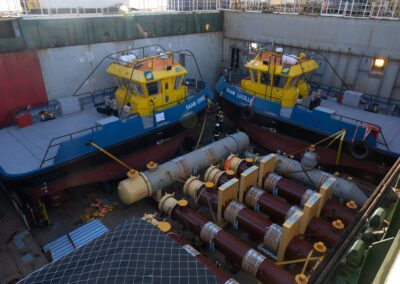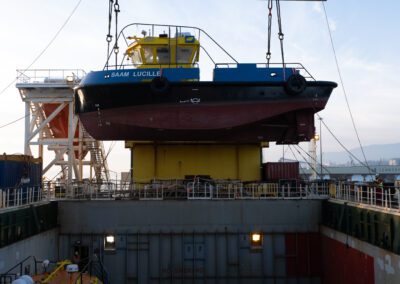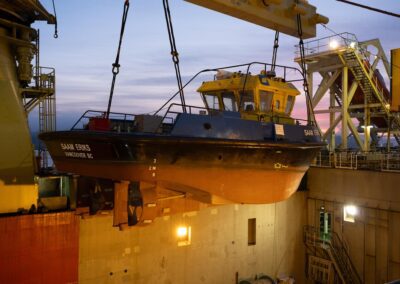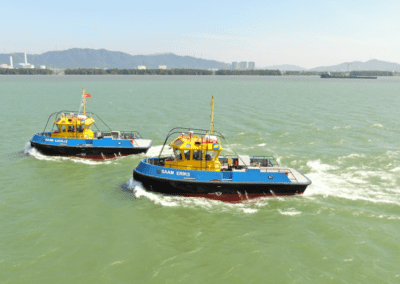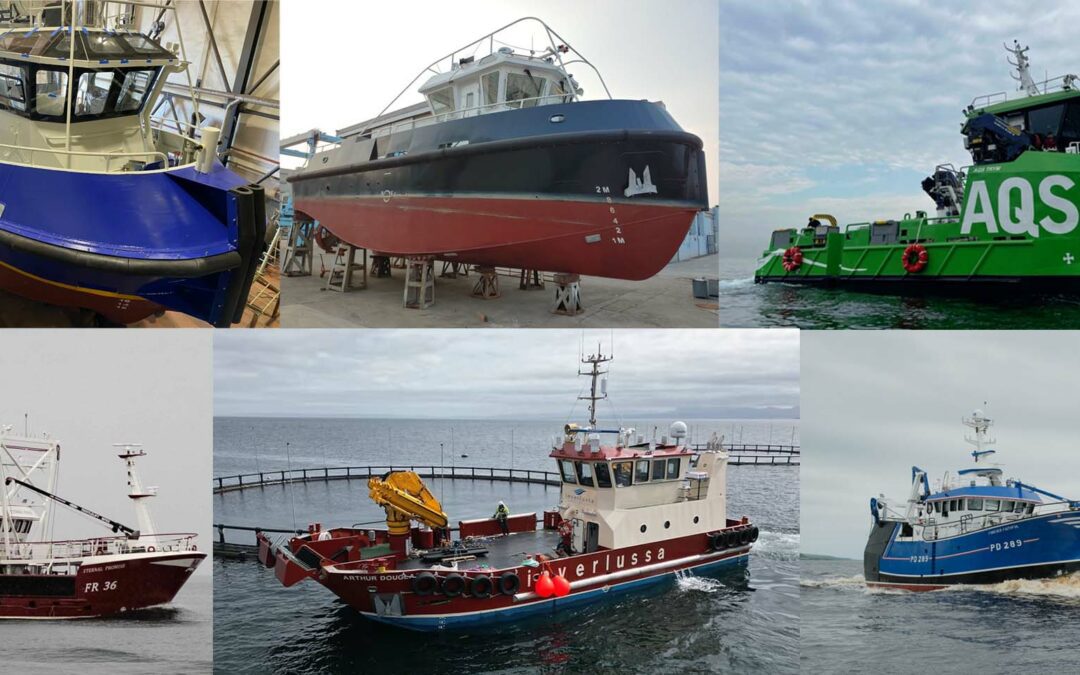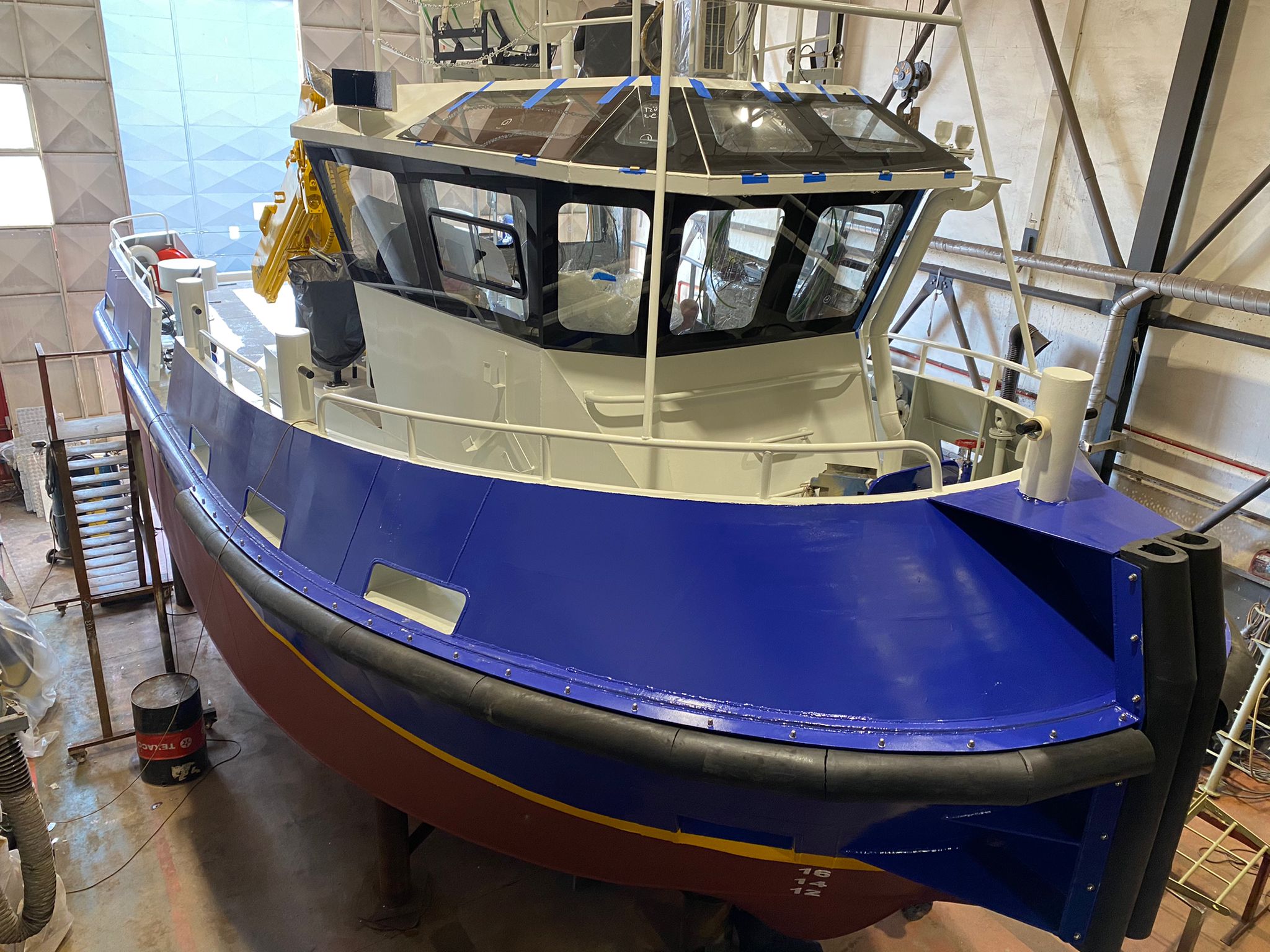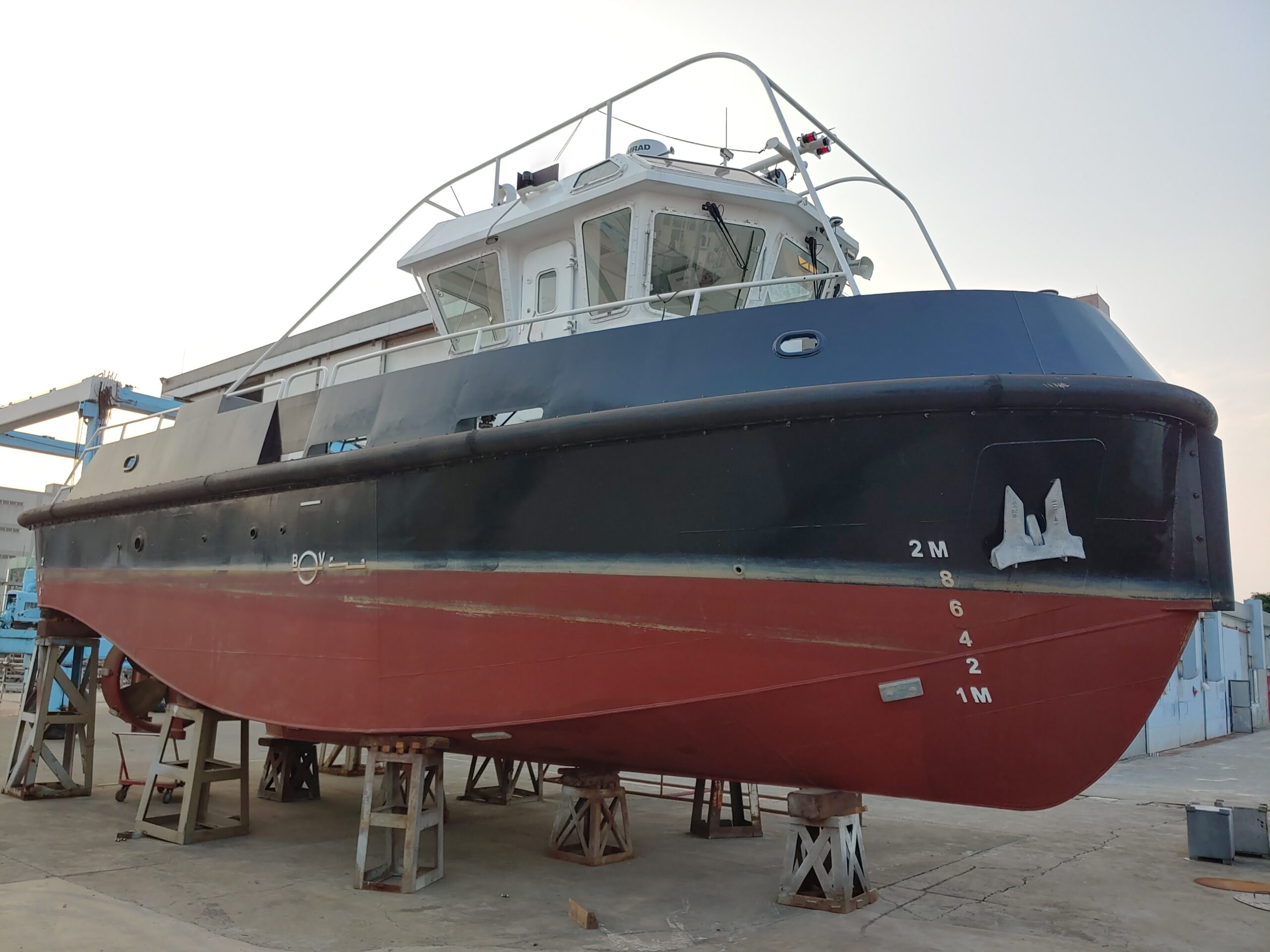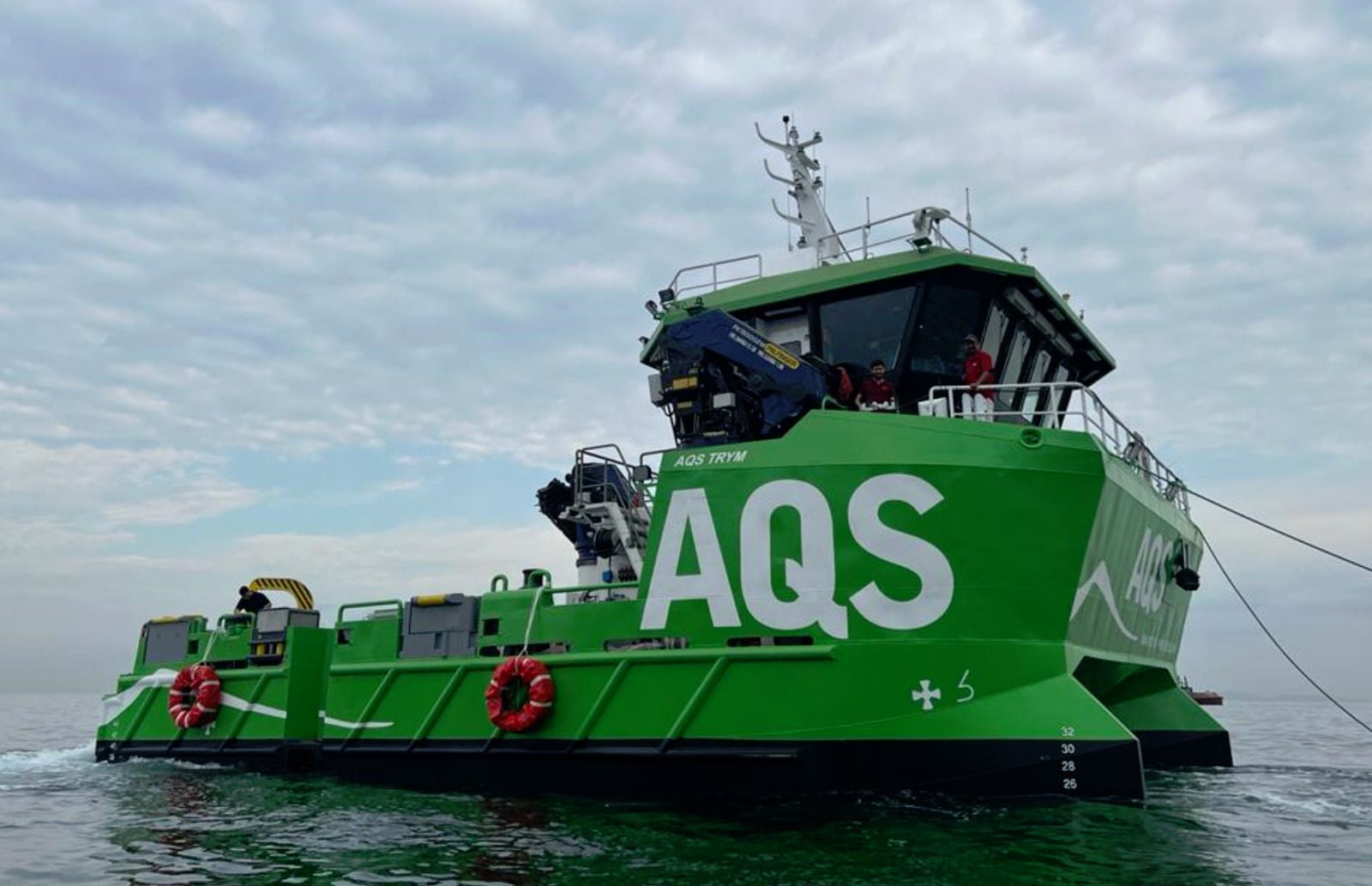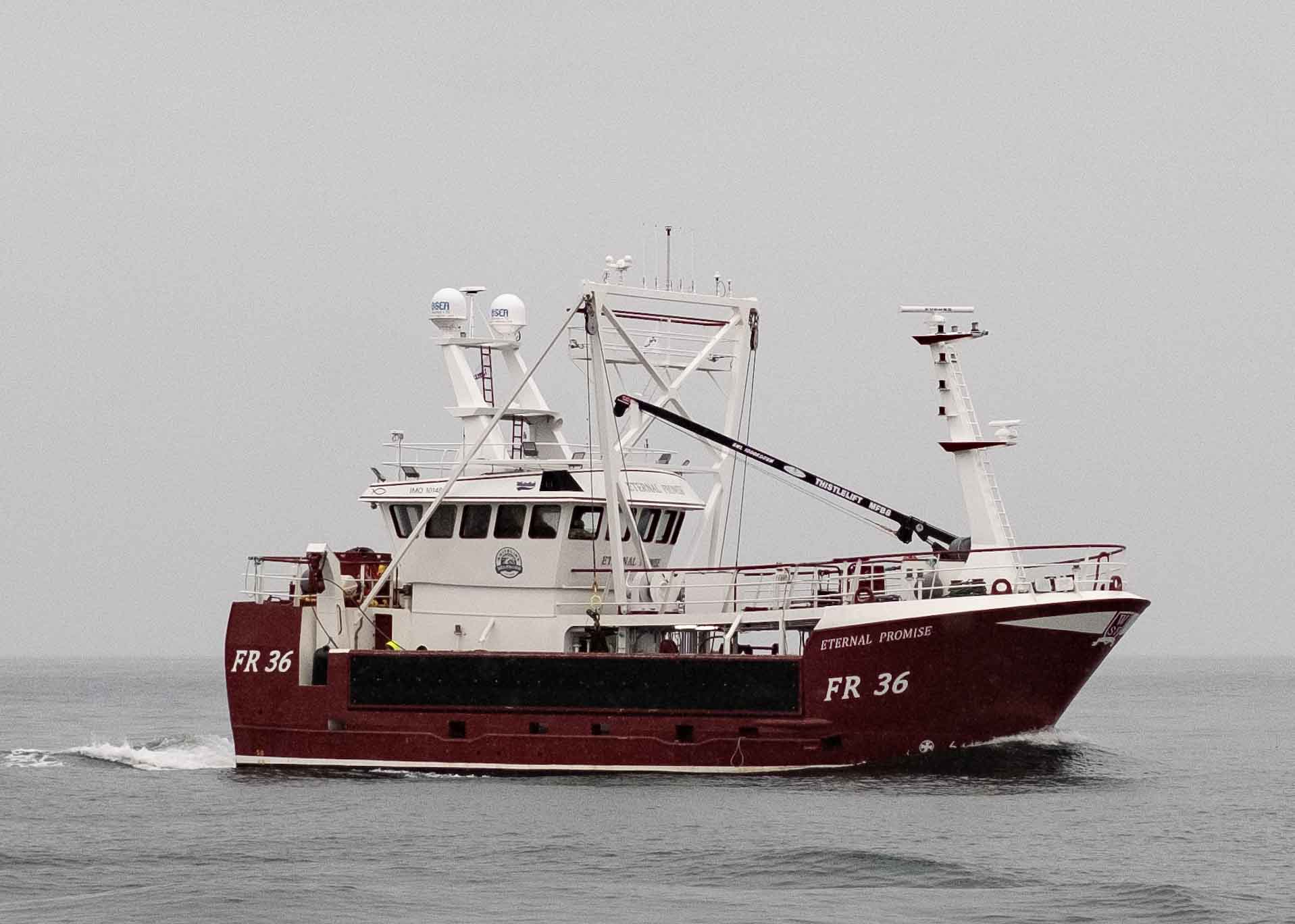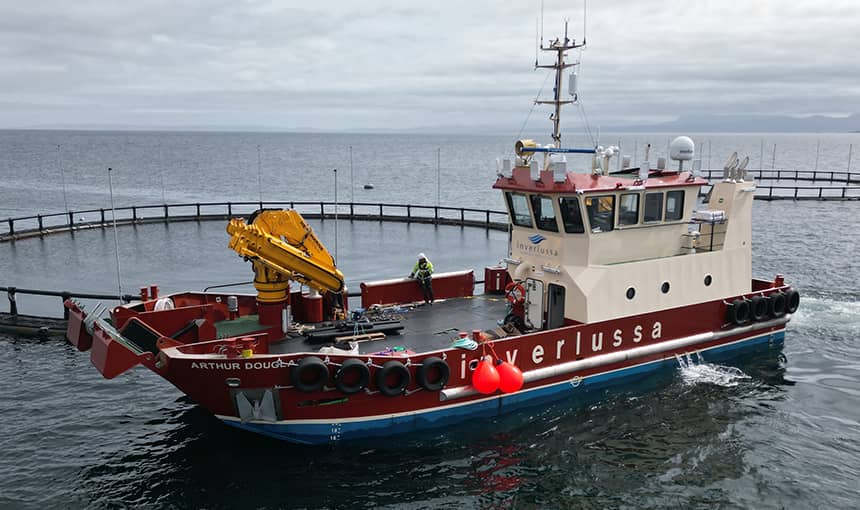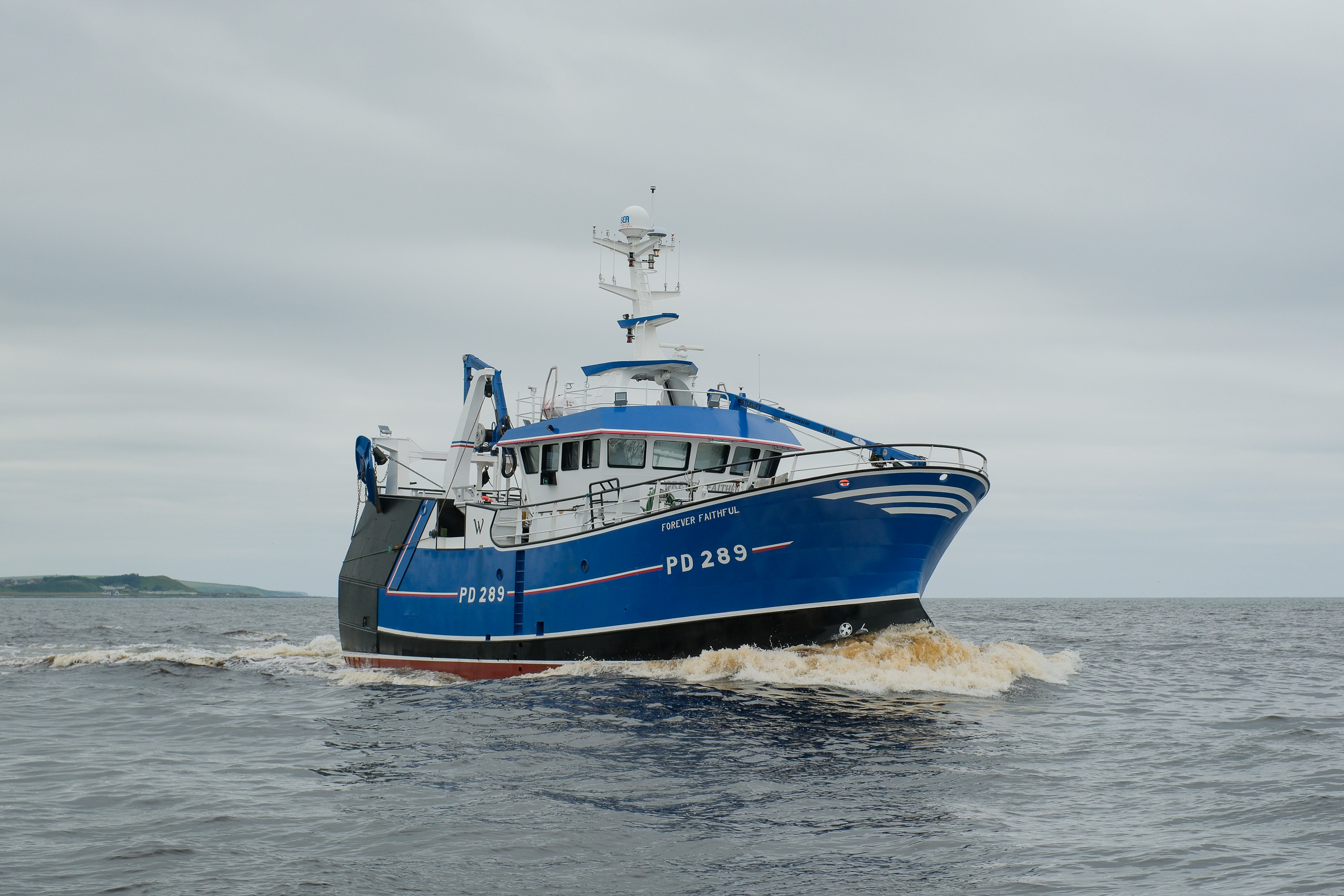Upon initial discussion of the new build, the decision was taken to develop a new hull form, with the aim of providing good sea keeping qualities, high propulsion efficiency, as well as improved living conditions for the crew onboard.
To achieve these objectives, Macduff Shipyards in conjunction with Macduff Ship Design, set out to develop the new hull form, which would have a waterline length of 25 metres, a registered length of just below 24 metres, and a breadth of 7.5 metres. The hull was compared against previous designs by the Wolfson Unit in Southampton, who utilised Computational Fluid Dynamic technology to assess the hull resistance at a range of different speeds, as well as visualise where the major resistance was occurring. With this information, progressive design alterations were made, to further reduce the resistance, and improve the wake that the propeller operates in. The initial results from sea trials were very encouraging, with a good speed to power witnessed, and the vessel punching effectively into head seas, with little effect on speed.
As well as the hull form, the general arrangement of the vessel was carefully considered and set out to increase crew comfort, with a focus on reducing noise levels in the living spaces within. Given the generous length of the hull, and the yards experience with noise assessments onboard vessels, it was decided to arrange the vessel with the crew cabins fitted amidships, between the engine room aft and the fish hold forward. By placing the cabins amidships, they were moved away from the propeller which is one of the primary noise sources onboard. As well as this, the galley and mess area were situated athwartships, above the cabins below, with no part adjacent to the engine room. Another effort to reduce noise was to route the engine exhaust pipes up the trawl gallows, instead of near the wheelhouse where they would traditionally be. During sea trials, the noise levels were measured and a noticeable reduction in dB was witnessed, with an absence of any propeller noise or vibration in living compartments.
The GRACIOUS was built indoors from start to completion, in the shipyards dedicated building hall at its Macduff yard. The vessel features a steel hull, and aluminium wheelhouse and mast, which were all cut by Macduff Profilers using CNC plasma and gas cutting machines. The steel kit was supplied by Macduff Ship Design.
In terms of main machinery, the GRACIOUS features a Caterpillar C32 main engine, rated 559 kW @ 1800 rpm. This is coupled to a Masson Marine W7400 gearbox, with a large reduction ratio of 9.077:1, which drives the 2.5 m diameter propeller, fitted within a high thrust nozzle. GRACIOUS is the eleventh new build fishing vessel delivered with this propulsion package by the yard, which has been well proven to be reliable and robust. The main engine is the first Tier III certified C32 fitted in the UK, on any vessel, with the SCR and ancillary equipment for UREA dosing and NOx monitoring supplied by FINNING CATERPILLAR. A stainless-steel urea tank is situated in the engine room, with capacity of near 2,000 litres.
Cooling for all engines, as well as the hydraulic system, was provided by using closed loop fresh-water systems with Blokland Non-Ferro supplying the box coolers. The GRACIOUS features a new design of rudder blade, developed by the yard, with CFD analysis conducted by the Wolfson Unit in Southampton. The rudder features two blades of aerofoil profile, driven by a Scan Steering MT 1000 steering gear unit. The system features no linkages and is simple to fabricate and maintain.
Main hydraulic power onboard is provided by a Hyundai 4AD086 auxiliary engine, with power output off 199 kW @ 1500 rpm, which drives two Kawasaki swash plate hydraulic pumps. In addition to this, two 45 kW electric motors are fitted, each driving an independent hydraulic pump, which can be utilised as a net retrieve system, or for using hydraulic equipment in the harbour with only one generator set running. The hydraulic system is a load sensing type system, with electric control valves and remote joysticks fitted at the machinery. This system delivers power only when requested, with the system running idle when not in use, saving fuel and reducing noise throughout the vessel.
The deck machinery package was supplied by the yard, with a triple barrel trawl winch fitted with Hagglunds compact CA210 motor, as well as two split net drums each with two Hagglunds compact CA70 motos. Thistle Marine of Peterhead supplied the MFB8 landing crane, along with a BK13 powerblock crane, both with slew ring base. A dynamic S45 gilson winch is fitted for lifting the catch onboard, and a small Rotzler hoisting winch is fitted to assist unloading the catch at the end of the trip.
Electrical power onboard is provided by two Mitsubishi generator sets, each 98 ekW in power output and capable of running the ships power in addition to one of the 45 kW hydraulic motor pump sets. If two pump sets are required, the second generator can be started to run it.
The electrical system onboard was designed and manufactured by R D Downie, who supplied the switchboards, frequency drives for motors, starter panels for the machinery, fire/bilge/gas alarm panels, and battery systems.
The fish processing system was designed by the yard, with the catch handling system built by Northeast Fabricators, all from marine grade stainless steel.
The fish hold refrigeration system was designed and installed by Premier Refrigeration, who also supplied and installed the Geneglace 2.5 t ice maker. The equipment was all housed in a dedicated room situated between the sorting area and the winch room forward. The fish hold was finished off with gel coated fibreglass panels and insulated to a high level to save energy and retain cold. A dedicated, fixed, fish hold access ladder was integrated into the walls of the fish hold, to improve crew safety.
The vessel was painted to a high standard, using quality paint provided by International Paints.
LIST OF MAJOR SUPPLIERS
Builder – Macduff Shipyards
Designer – Macduff Ship Design / Macduff Shipyards
Main engine – Caterpillar C32 supplied by Finning Power Systems, UK
Propeller and Nozzle – Kort Propulsion, UK
Gearbox – Masson Marine, France
Construction drawings and stability information – Macduff Ship Design
Hyundai auxiliary engine – Watermota, UK
Mitsubishi generator sets – Macduff Diesels Ltd, UK
Box cooling systems for each engine and the hydraulic circuit – Blokland Non Ferro, Netherlands
Pumps – Azcue Pumps SA, Spain
Deck machinery equipment – Macduff Shipyards
Deck cranes – Thistle Marine, UK
Fire doors – B-15 Marine Ltd, UK
Weathertight doors – Winel, Netherlands
Rudder system – Macduff Shipyards
Steering gear – Scan Steering APS, Denmark
Wheelhouse windows and portlights – HK Van Wingerden & An BV, Netherlands
Fish handling system – North East Fabricators, UK
Refrigeration system and ice machine – Premier Refrigeration, UK
Paint system – International, UK
Wheelhouse chairs – Norsap, UK
Oil fuel filter/separator and main engine oil fine filter – CC Jensen, UK
Pressure washers – Grampian Power Clean, UK
Anchors and chain – Fendercare Marine, UK
Switchboard and electrical system – R D Downie Limited, UK
